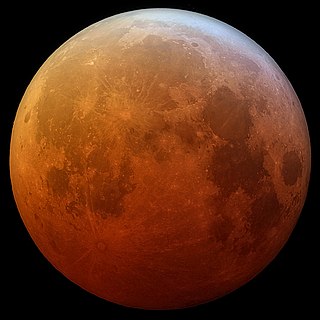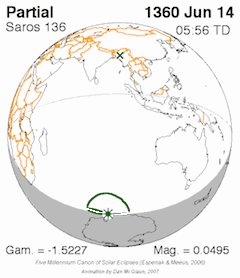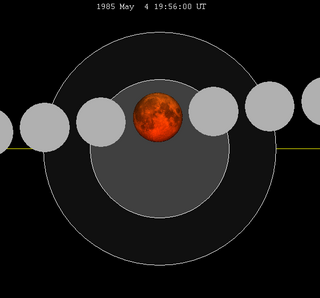On Earth, by the Moon
Main article: Lists of solar eclipses
| The arts | |
|---|---|
| Communication and technology | |
| Philosophy and science | |
| Politics and office-holders | |
| Sport | |
| This article includes an astronomy-related list of lists. |
There are several lists of lunar eclipses
| This article includes an astronomy-related list of lists. |

A lunar eclipse occurs when the Moon moves into the Earth's shadow. This can occur only when the Sun, Earth, and Moon are exactly or very closely aligned with Earth between the other two, and only on the night of a full moon. The type and length of a lunar eclipse depend on the Moon's proximity to either node of its orbit.

Eclipses may occur repeatedly, separated by certain intervals of time: these intervals are called eclipse cycles. The series of eclipses separated by a repeat of one of these intervals is called an eclipse series.

A total lunar eclipse took place on May 16, 2003, the first of two total lunar eclipses in 2003, the other being on November 9, 2003.

A total lunar eclipse took place on April 15, 2014. It was the first of two total lunar eclipses in 2014, and the first in a tetrad. Subsequent eclipses in the tetrad are those of October 8, 2014, April 4, 2015, and September 28, 2015. Occurring 6.7 days after apogee, the Moon's apparent diameter was smaller.

A total lunar eclipse took place on October 8, 2014. It is the second of two total lunar eclipses in 2014, and the second in a tetrad. Other eclipses in the tetrad are those of April 15, 2014, April 4, 2015, and September 28, 2015. Occurring only 2.1 days after perigee, the Moon's apparent diameter was larger, 1960.6 arcseconds.

A total lunar eclipse took place on 4 April 2015. It is the former of two total lunar eclipses in 2015, and the third in a tetrad. Other eclipses in the tetrad are those of 15 April 2014, 8 October 2014, and 28 September 2015.

A total lunar eclipse took place between September 27 and 28, 2015. It was seen on Sunday evening, September 27, in the Americas; while in Europe, Africa, and the Middle East, it was seen in the early hours of Monday morning, September 28. It was the latter of two total lunar eclipses in 2015, and the final in a tetrad. Other eclipses in the tetrad are those of April 15, 2014, October 8, 2014, and April 4, 2015.
A total lunar eclipse will take place on October 19, 2051. The moon will pass through the center of the Earth's shadow.

A total lunar eclipse took place on May 4, 1985, the first of two total lunar eclipses in 1985, the second being on October 28, 1985.

A total lunar eclipse will take place on April 25, 2032.

A total lunar eclipse took place on April 24, 1967, the first of two total lunar eclipses in 1967, the second being on October 18, 1967.

A total penumbral lunar eclipse is a lunar eclipse that occurs when the Moon becomes completely immersed in the penumbral cone of the Earth without touching the umbra.
A total lunar eclipse will take place on March 25, 2043.
A total lunar eclipse will take place on May 6, 2050.
A total lunar eclipse will take place on April 26, 2051.
A total lunar eclipse will take place on October 30, 2050.

The blood moon prophecies are a series of prophecies in the Bible preached by Christian preachers John Hagee and Mark Biltz, which state that a tetrad which began with the April 2014 lunar eclipse is the beginning of the end times as described in the Bible in the Book of Joel, Acts 2:20, and Revelation 6:12. The tetrad ended with the lunar eclipse on September 27–28, 2015.

In astronomy, a tetrad is a set of four total lunar eclipses within two consecutive years.
This page gives statistics for lunar eclipses grouped by century. Detailed information about tetrads, timing, and other facts can be found at the linked references.